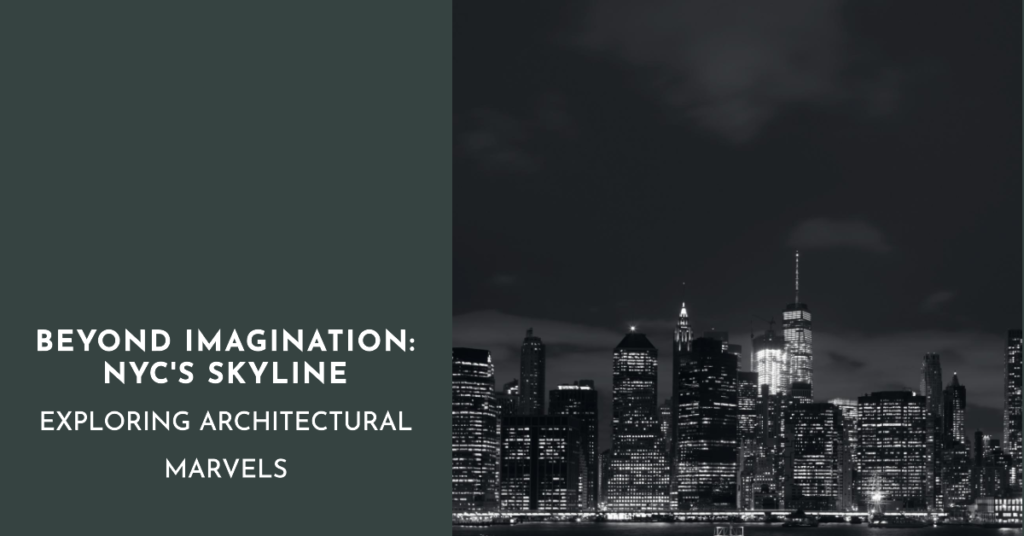
Table of Contents
Introduction of Exploring the Architectural Marvels of NYC’s Skyline:
Beyond Imagination: Exploring the Architectural Marvels of NYC’s Skyline , Embark on a journey through the bustling streets of New York City, where skyscrapers pierce the clouds and redefine the very essence of modern architecture. In this blog post, we delve into the architectural marvels that grace the iconic skyline of the Big Apple, showcasing how innovative design and engineering have transformed the cityscape into a realm of awe-inspiring beauty and functionality.
Setting the Stage:
Before we dive into the specifics of each architectural gem, it’s essential to understand the context in which these structures emerge. New York City, often dubbed as the concrete jungle, is a melting pot of culture, commerce, and creativity. Its skyline serves as a testament to human ingenuity, where each towering edifice tells a story of ambition and aspiration. From the historic landmarks of the past to the cutting-edge skyscrapers of the present, the city’s skyline is a dynamic canvas that evolves with time.
Iconic Landmarks:
No exploration of NYC’s skyline is complete without paying homage to its most iconic landmarks. The Empire State Building stands as a symbol of Art Deco elegance, rising majestically above the city since its completion in 1931. Its timeless allure continues to captivate visitors from around the globe, offering panoramic views of Manhattan and beyond from its observation decks. Similarly, the Chrysler Building, with its distinctive spire adorned with stainless steel gargoyles, remains a quintessential part of New York’s architectural identity.
Innovative Designs:
As the cityscape evolves, so too does the approach to architectural design. One World Trade Center, also known as the Freedom Tower, stands as a testament to resilience and innovation in the wake of tragedy. Its sleek glass facade and soaring height make it a modern marvel, embodying the spirit of renewal and hope. The High Line, a unique urban park built atop a former railway line, showcases the ingenuity of adaptive reuse, blending green space with industrial heritage seamlessly.


ustainable Solutions:
In an age of increasing environmental awareness, sustainability has become a driving force in architectural innovation. The Bank of America Tower at One Bryant Park sets a shining example of green design, boasting LEED Platinum certification for its energy-efficient features and eco-friendly construction materials. Its crystalline form not only enhances the skyline but also reduces carbon emissions, demonstrating the harmonious coexistence of architecture and nature.
Technological Advancements:
Advancements in technology have revolutionized the way architects conceptualize and realize their visions. The Hudson Yards development, one of the largest real estate projects in the city’s history, showcases the integration of cutting-edge digital tools such as Building Information Modeling (BIM) to streamline the construction process and optimize building performance. From virtual reality simulations to drone-assisted site surveys, these tools empower constructors to visualize and execute projects with unprecedented precision.
Cultural Influences:
New York City’s skyline reflects not only architectural prowess but also cultural diversity and heritage. The Hearst Tower, with its striking diagrid facade, pays homage to the city’s history of innovation while embracing contemporary design principles. Its fusion of old and new serves as a testament to the enduring legacy of craftsmanship and creativity that defines the city’s architectural landscape.
Skyline of the Future:
As we look towards the future, the skyline of New York City continues to evolve, promising even more daring and innovative architectural feats. The planned construction of The Spiral, a towering mixed-use skyscraper designed by Bjarke Ingels Group, exemplifies this forward-thinking approach with its cascading terraces and integrated green spaces. This visionary project heralds a new era of sustainable urban living, where design and functionality converge to shape the cities of tomorrow.
Conclusion:
In conclusion, the architectural marvels that adorn the skyline of New York City are more than just buildings; they are testaments to human creativity, resilience, and ambition. From iconic landmarks steeped in history to cutting-edge skyscrapers that push the boundaries of design, each structure contributes to the rich tapestry of the city’s built environment. As we continue to innovate and imagine, the skyline of NYC will remain a beacon of inspiration for generations to come, reminding us of the limitless possibilities that await beyond imagination.


